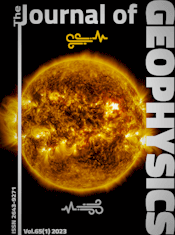Full wave theory applied to a discontinuous velocity increase: the inner core boundary
Article Sidebar

Vols. 1-18 (1924-1944), ISSN 0044-2801
Main Article Content
Abstract
Recent developments in the computation of theoretical seismograms have shown the advantages of numerical integrations in the complex ray parameter plane. We here extend the approach, to calculate the amplitude of body waves interacting with a discontinuous velocity increase. The method incorporates a complex velocity profile to account for attenuation and the uniformly asymptotic method of Langer to account for frequency-dependence of reflection-transmission coefficients near grazing incidence. In the integrand of reflection-transmission coefficients, the Debye ray expansion is not made where it is poorly convergent near critical incidence. The method thereby correctly evaluates all the waves in the high velocity medium that are repeatedly refracted back up to, and reflected from, the low velocity medium. Calculations are equally efficient both for Earth models specified on discrete radii or as analytic functions of radius. The method is used to calculate theoretical seismograms for PKP waves in the PEM Earth model in the distance range 110°–152° and in Earth models 1066B and C2 in the distance range 112°–132°. Calculations of the amplitude near point D of the travel time curve for PKP (which is the critical distance of K waves incident from the fluid core upon the solid inner core) indicate that at finite frequencies the amplitude maximum associated with critical incidence is smaller than that that would be inferred from frequency independent reflection-transmission coefficients. At lower frequencies the maximum is displaced to a longer distance than D. Comparison of observed and calculated seismograms indicates that the PEM model having a P velocity jump of 0.83 km/s at the inner core can fit the observed amplitudes. Consequently the data do not require an anomalous P velocity gradient at the top of the inner core. A low frequency precursor to the DF branch of PKP at distances shorter than the B caustic at 146° agrees with Buchbinder's (1974) explanation of diffraction from the B caustic.
 ARK: https://n2t.net/ark:/88439/y040552
ARK: https://n2t.net/ark:/88439/y040552
Permalink: https://geophysicsjournal.com/article/164
Article Details
References
Buchbinder, G.G.R. (1974) Diffraction from the PKP caustic B. Bull. Seism. Soc. Am. 64:33-43
Cerveny, V., Ravindra, R. (1971) Theory of seismic head waves. Toronto and Buffalo: Univ. of Toronto Press
Chapman, C.H. (1976) A first-motion alternative to geomet rical ray theory. Geophys. Res. Letts.
Choy, G. (1977) Theoretical seismograms of core phases calculated by a frequency-dependent full wave theory, and their interpreta tion. To appear in Geophys. J. R. Astr. Soc.
Cormier, Y.F., Richards, P.G. (1976) Comments on 'T he damping of core waves' by Anthony Qamar and Alfredo Eisenberg. J. Geophys. Res. 81:3066-3068
Cormier, Y.F. (1976) Ph.D. Thesis, Columbia University, New York, NY
Debye, P.J. (1908) The electromagnetic field surro unding a cylinder a nd the theory of the rainbow. Phys. Z. 9:775-778
Doornbos, D.J. (1974) Ane last icity of the in ner core. Geophys. J. R. Astr. Soc. 38:397-415
Dziewonski, A.M., Hales, A.L., Lapwood, E.R. (1975) Parameterically simple earth models consistent with geophysical data. Phys. Earth Planet. Int. 10:12-48
Franz, W. (1957) Theorie der Beugung elektromagnetischer Wellen. Springer, Berlin-New York
Fuchs, K., Muller, G. (1971) Computation of synthetic seismograms with the reflectivity method and comparison with observations. Geophys. J. R. Astr. Soc. 23:417-433
Gilbert, F., Helmberger, D.V. (1972) Generalized ray theory for a layered sphere. Geophys. J. R. Astr. Soc. 27:57-80
Gilbert, F., Dziewonski, A.M. (1975) An application of normal mode theory to the retrieval of structural parameters and source mechanisms from seismic spectra. Phil. Trans. R. Soc. Lond., Ser. A 278:187-269
Helmberger, D.V. (1968) The crust-mantle transition in the Bering Sea. Bull. Seism. Soc. Am. 58:179-214
Hill, D.P. (1971) Velocity gradients and anelasticity from crustal body wave amplitudes. J. Geophys. Res. 76:3309-3325
Julian, B.R., Anderson, D.L. (1968) Travel times, apparent velocities and amplitudes of body waves. Bull. Seism. Soc. Am. 58:339-366
Kennett, B.L.N. (1975) The effects of attenuation on seismograms. Bull. Seism. Soc. Am. 65:1643-1652
Langer, R.E. (1949) The asymptotic solutions of ordinary linear differential equations to the second order, with special reference to a turning point. Trans. Am. Math. Soc. 67:461-490
Ludwig, D. (1973) Diffraction by a circular cavity. J. Math. Phys. 11, 1617-1629, 1970 Millier, G.: Amplitude studies of core phases. J. Geophys. Res. 78:3469-3490
Nussenzveig, H.M. (1969) High-frequency scattering by a transparent sphere. I. Direct reflection and transmission. J. Math. Phys. 10:82-124
Phinney, R.A., Alexander, S.S. (1966) P wave diffraction theory and the structure of the core-mantle boundary. J. Geophys. Res. 71:5959-5975
Rayleigh, Lord (1910) The problem of the whispering gallery. Phil. Mag. 20:1001-1004
Richards, P.G. (1973) Calculation of body waves for caustics and tunnelling in core phases. Geophys. J. R. astr. Soc. 35:243-264
Richards, P.G. (1974) Weakly coupled potentials for high-frequency elastic waves in continuously stratified media. Bull. Seism. Soc. Am. 64:1575-1588
Richards, P.G. (1976) On the adequacy of plane-wave reflection-transmission coefficients in the analysis of seismic body waves. Bull. Seism. Soc. Am. 66:701-718
Scholte, J.G.J. (1956) On seismic waves in a spherical earth. Koninkl. Med. Meteorol. Inst. Publ. 65:1-55
Oberall, H. (1975) Surface waves in acoustics. In: W.P., Mason, R.N. Thruston (Eds.) Physical acoustics, Vol. 10, pp.1-60. Academic Press, New York











